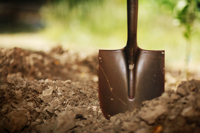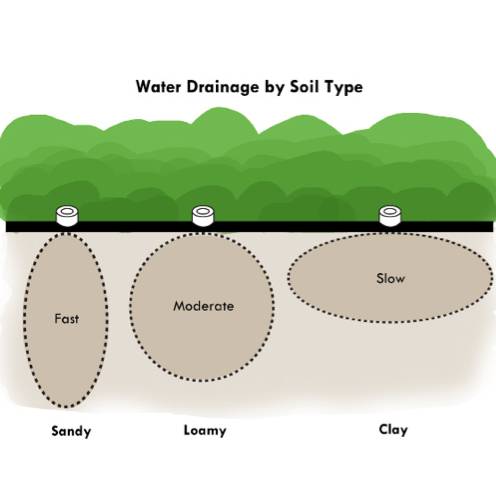Know Your Soil Type
When putting together your drip irrigation system, it is useful to know what type of soil you have in your  planting area. You do not need to be a soil expert, but you should be aware that water moves differently and creates different wetting patterns through the different types of soil: sand, loam and clay. The term wetting pattern refers to the way that water is distributed below the surface of the soil both vertically, through the force of gravity, and horizontally, through the capillary properties within the soil.
planting area. You do not need to be a soil expert, but you should be aware that water moves differently and creates different wetting patterns through the different types of soil: sand, loam and clay. The term wetting pattern refers to the way that water is distributed below the surface of the soil both vertically, through the force of gravity, and horizontally, through the capillary properties within the soil.
Sandy soil: Water moves quickly through sandy soil and does not travel far from the dripper. The wetting pattern is much more vertical than horizontal in this type of soil. If your soil is sandy, then you may want to use higher flow drippers and drippers that are spaced closer together to ensure your plants receive enough water. With a higher flow, you may also want to water for shorter durations, but more often.
Loamy soil: Loamy soil is more dense than sandy soil so water will travel slower allowing it to spread more evenly through the soil both vertically and horizontally. Mid-range drip emitters may be a good choice and you can space drippers further apart since the wetting pattern will be larger.
Clay soil: This type of soil is very dense, which causes water to be absorbed very slowly. Drippers with the lowest flow rate are a good choice to prevent the water from pooling on the surface of the soil near the plant. Any water at the surface of the soil could eventually be lost to evaporation or runoff to areas you don't wish to water. With lower flow rate drippers, you should water for longer durations to ensure your plants receive enough water.

For any soil type, you should only see a small wet spot of about 3 to 4 inches in diameter on the ground below a dripper. All the action is really happening below the surface. To determine the actual wetting pattern for your specific soil, run your drip system for about 30 minutes, let sit for 30 minutes and then dig into the soil below a dripper to see how far the water has traveled vertically and horizontally. You'll be able to see exactly how the water is dispersing at the root zones of your plants, and you can adjust your system setup accordingly if necessary.
A simple method to determine your soil type is to grab a handful of dry soil from the area or areas you wish to drip irrigate. Make a fist while holding the dry soil in your hand, then open your fist. If you have sandy soil, the soil in your hand will crumble without hesitation. If the soil holds together but slowly falls apart, then you have loamy soil. Lastly, if the soil holds its shape, then you have clay soil. This method is not scientific, but works well for most people. If you need a more detailed analysis, there are agencies that can test your soil for you.
By knowing your soil type and how water behaves under the surface, you'll be able to design your drip irrigation system with the right components and the right watering schedule to ensure your plants stay healthy.
Happy gardening!
Additional Resources You May Like
The Importance of Soil Testing